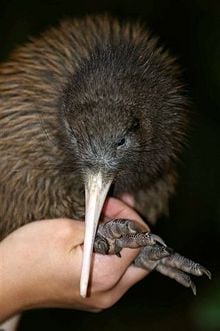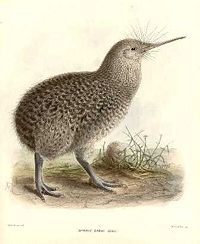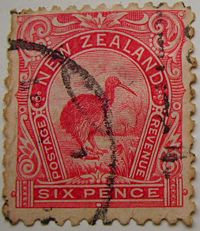Kiwi
| Kiwi | ||||||||||||
|---|---|---|---|---|---|---|---|---|---|---|---|---|
 | ||||||||||||
| Scientific classification | ||||||||||||
| ||||||||||||
|
See text. |
Kiwi is the common name for any of the flightless birds endemic to New Zealand comprising the genus Apteryx, characterized by rudimentary wings, short and stout legs, dark plumage, poor vision, and a long, slender, pointed bill with nostrils uniquely opening at the tip rather than base. At around the size of a domestic chicken, kiwi are by far the smallest living ratites—a group of flightless birds that also includes ostriches, emus, rheas, and elephant birds. Apteryx is the only genus in the family Apterygidae. There are about five species of kiwi, all of which are endangered.
The kiwi is so associated with New Zealand that it is a national symbol of New Zealand, with the term used to refer to any inhabitant of New Zealand and a slang term for the New Zealand dollar. It also is the common name of a fruit also called the Chinese gooseberry.
Overview and description
Kiwi's are part of a group of birds known as ratites— flightless birds characterized by a flat, raft-like sternum (breastbone) lacking the keel for attachment of wing muscles that is typical of most flying birds and some other flightless birds. Kiwis are by far the smallest extant ratites. Other ratites include the African ostrich, the Australian emu, the Australian and Oceania cassowary, and two species of South American rheas. Recently extinct forms include elephant birds and moas.
Kiwi are chicken-sized birds, ranging in size from about 25 centimeters (10 inches) tall and 1.2 kilograms (2.7 pounds) in the little spotted kiwi (Apteryx owenii) to about 45 centimeters (17.7 inches) high and 3.3 kilograms &7.3 pounds) in the great spotted kiwi (Apteryx haastii). Their rudimentary wings are hidden within the dark, soft, plumage and their tail also is very short. They have clawed, four-toed feet on short, sturdy legs, and a long, slender, pointed and curved bill that may be 15 centimeters (6 inches) long. Unlike other birds, the nostrils end on the tip of this beak rather than at the base.
Kiwi's are shy birds that nest in deep burrows and are usually nocturnal. They use a highly developed sense of smell to find small insects and grubs in the soil. Kiwis have poor vision. Kiwi are notable for laying eggs that are very large in relation to their body size. A kiwi egg may equal 15 to 20 percent of the body mass of a female kiwi. The males incubate the eggs.
Kiwi {kē'wē; kee-wee) is a word that comes from the Māori language, a Malayo-Polynesian language of the Austronesian family, spoken by about 100,000 of New Zealand's inhabitants . The name may come from the cry that the kiwi makes, which sounds like "kiwi, kiwi." The word first appears in the English language in 1835 in describing this bird (Metcalf 1999).
The scientific name Apteryx means wingless.
The first kiwi specimen to be studied by Europeans was a kiwi skin brought to George Shaw by Captain Andrew Barclay aboard the ship Providence, who was reported to have been given it by a sealer in Sydney Harbour around 1811. George Shaw gave the kiwi its scientific name and drew sketches of the way he imagined a live bird to look which appeared as plates 1057 and 1058 in volume 24 of The Naturalist's Miscellany in 1813.
It was long presumed that the kiwi's closest relatives were the other New Zealand ratites, the moa. However recent DNA studies indicate that the Ostrich is more closely related to the moa and the kiwi's closest relatives are the Emu and the cassowaries. This theory suggests that the kiwi's ancestors arrived in New Zealand from elsewhere in Australasia well after the moa. According to British scientists, the kiwi may be an ancient import from Australia. Researchers of Oxford University have found DNA evidence connected to Australia's Emu and the Ostrich of Africa. Upon examining DNA from New Zealand's native moa, they believe that the kiwi is more closely related to its Australian cousins.[1]
Species
Currently, there are five accepted species (one of which has four sub-species), plus one to be formally described.
- The largest species is the Great Spotted Kiwi or Roroa, Apteryx haastii, which stands about 45 cm (17.7 inches) high and weighs about 3.3 kg. (Males about 2.4 kg) It has grey-brown plumage with lighter bands. The female lays just one egg, with both sexes incubating. Population is estimated to be over 20,000, distributed through the more mountainous parts of northwest Nelson, the northern West Coast, and the Southern Alps.
- The very small Little Spotted Kiwi, Apteryx owenii is unable to withstand predation by introduced pigs, stoats and cats and is extinct on the mainland because of these reasons. About 1350 remain on Kapiti Island and it has been introduced to other predator-free islands and appears to be becoming established with about 50 'Little Spots' on each island. A docile bird the size of a bantam, it stands 25 cm (9.8 inches) high and the female weighs 1.3 kg. She lays one egg which is incubated by the male.
- The Rowi, also known as the Okarito Brown Kiwi or Apteryx rowi, is a recently identified species, slightly smaller, with a greyish tinge to the plumage and sometimes white facial feathers. Females lay as many as three eggs in a season, each one in a different nest. Male and female both incubate. Distribution of these kiwi are limited to a small area on the west coast of the South Island of New Zealand.
- The Tokoeka, Apteryx australis, relatively common species of kiwi known from south and west parts of South Island that occurs at most elevations. It is approximately the size of the Great Spotted Kiwi and is similar in appearance to the Brown Kiwi but its plumage is lighter in colour.
- The Stewart Island Tokoeka, Apteryx australis lawryi, is a subspecies of Tokoeka from Stewart Island.
- The Haast Tokoeka, Apteryx australis ?, is the rarest species of kiwi with only about 300 individuals. It was identified as a distinct form in 1993. It only occurs in a restricted area in South Island's Haast Range at an altitude of 1,500 m. This form is distinguished by a more strongly downcurved bill and more rufous plumage.
- The Northern Fiordland Tokoeka ( Apteryx australis ?) and Southern Fiordland Tokoeka (Apteryx australis ?) live in the remote southwest part of South Island known as Fiordland. These sub-species of Tokoeka are relatively common and are nearly 40 cm (16 inches) tall.
- The North Island Brown Kiwi, Apteryx mantelli or Apteryx australis before 2000 (and still in some sources), is widespread in the northern two-thirds of the North Island and, with about 35,000 remaining, is the most common kiwi. Females stand about 40 cm (16 inches) high and weigh about 2.8 kg, the males about 2.2 kg. The North Island Brown has demonstrated a remarkable resilience: it adapts to a wide range of habitats, even non-native forests and some farmland. The plumage is streaky red-brown and spiky. The female usually lays two eggs, which are incubated by the male.
Analysis of mitochondrial DNA, ecology, behaviour, morphology, geographic distribution and parasites of the North Island Brown Kiwi has led scientists to propose that the Brown Kiwi is three distinct species. The North Island Brown Kiwi; the Okarito Brown Kiwi (Rowi), whose distribution is restricted to a single site on the West Coast of the South Island of New Zealand; and a third distinct population of the North Island Brown Kiwi, the Southern Tokoeka, distributed in the in lowland forest to the north of Franz Josef glacier in the South Island and on Stewart Island, with a small population near Haast being another possibly distinct species, the Haast Tokoeka.
Behaviour and ecology
Prior to the arrival of humans in the 13th century or earlier, New Zealand's only endemic mammals were three species of bat, and the ecological niches that in other parts of the world were filled by creatures as diverse as horses, wolves and mice were taken up by birds (and, to a lesser extent, reptiles).
Kiwi are shy and usually nocturnal. Their mostly nocturnal habits may be a result of habitat intrusion by predators, including humans: in areas of New Zealand where introduced predators have been removed, such as sanctuaries kiwi are often seen in daylight. Kiwi are creatures with a highly developed sense of smell, most unusual in a bird, and are the only birds with nostrils at the end of their long bill. Kiwi eat small invertebrates, seeds, grubs, and many varieties of worms. They also may eat fruit, small crayfish, eels and amphibians. Because their nostrils are located at the end of their long beaks, Kiwi can locate insects and worms underground without actually seeing or feeling them.[2]
Once bonded, a male and female kiwi tend to live their whole lives together as a monogamous couple. During the mating season, June to March, the pair call to each other at night, and meet in the nesting burrow every three days. These relationships may last for up to 20 years.[3] Kiwi eggs can weigh up to one quarter the weight of the female. Usually only one egg is laid per season. Although the kiwi is about the size of a domestic chicken, it is able to lay eggs that are about six times the size of a chicken's egg.[4]
Their adaptation to a terrestrial life is extensive: like all ratites they have no keel on the breastbone to anchor wing muscles, and barely any wings either: the vestiges are so small that they are invisible under the kiwi's bristly, hair-like, two-branched feathers. While birds generally have hollow bones to save weight and make flight practicable, kiwi have marrow, in the style of mammals. With no constraints on weight from flight requirements, some Brown Kiwi females carry and lay a single 450 g egg.
ReferencesISBN links support NWE through referral fees
- ↑ News In Science
- ↑ Because a bird's beak is generally measured from the tip to the nostril, this (technically) gives Kiwi the shortest beak of any bird.
- ↑ KiwiRecovery.org
- ↑ Producing an Egg. Retrieved 2007-08-13.
- Bizarre and Beautiful Noses. Sante Fe, New Mexico: John Muir Publications, 1993.
- Burbidge M.L., Colbourne R.M., Robertson H.A., and Baker A.J. (2003). Molecular and other biological evidence supports the recognition of at least three species of brown kiwi. Conservation Genetics, 4(2):167-177
- Cooper, Alan et al (2001). Complete mitochondrial genome sequences of two extinct moas clarify ratite evolution. Nature, 409: 704-707.
- News In Science
- NHNZ has made a 60 minute television documentary called Kiwi a Natural History, produced in 1991.
Metcalf, Allan A. 1999. The world in so many words: a country-by-country tour of words that have shaped our language. Boston: Houghton Mifflin. ISBN 0395959209.
External links
- Great Spotted Kiwi - ARKive
- Kiwi: New Zealand Department of Conservation
- H.A. Robertson (2003). Kiwi (Apteryx spp.) recovery plan 1996–2006. (Threatened Species Recovery Plan 50). Department of Conservation, Wellington, New Zealand. Retrieved 2007-09-19.
- Save The Kiwi (formerly Kiwi Recovery)
- Willowbank Wildlife Reserve, Christchurch, New Zealand
- Online Encyclopedia entry "Kiwi"
- TerraNature pages on kiwi
- How the Kiwi Lost his Wings (a Maori legend)
- Kiwi in Te Ara - the Encyclopedia of New Zealand
Credits
New World Encyclopedia writers and editors rewrote and completed the Wikipedia article in accordance with New World Encyclopedia standards. This article abides by terms of the Creative Commons CC-by-sa 3.0 License (CC-by-sa), which may be used and disseminated with proper attribution. Credit is due under the terms of this license that can reference both the New World Encyclopedia contributors and the selfless volunteer contributors of the Wikimedia Foundation. To cite this article click here for a list of acceptable citing formats.The history of earlier contributions by wikipedians is accessible to researchers here:
The history of this article since it was imported to New World Encyclopedia:
Note: Some restrictions may apply to use of individual images which are separately licensed.




